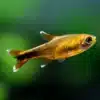-
×

-
×

-
×

-
×

-
×

-
×

Subtotal: £507.07














Emily Carter (verified owner) –
I recently added six Buenos Aires Tetras to my aquarium, and I couldn’t be happier! These little guys are not only beautiful, with their shimmering silver bodies and vibrant orange tips, but they are also incredibly lively and hardy. After two weeks, they have adjusted wonderfully, swimming in schools and showing off their playful nature.
What impressed me the most is how they thrive in various water conditions; this makes them a great choice for both beginners and experienced hobbyists. I’ve kept neon tetras in the past, but I find the Buenos Aires Tetras to be more active and engaging. They really brighten up the tank and have a delightful personality.
One minor point to note is that they can be a bit nippy with smaller tank mates, so I recommend keeping them with similarly sized fish. Overall, these tetras have added so much joy to my aquarium, and I highly recommend them to anyone looking to enhance their tropical fish collection. Whether you’re just starting out or a seasoned aquarist, these fish are a fantastic addition!
Emily Carter (verified owner) –
I recently added 6 Buenos Aires Tetras to my community tank, and I couldn’t be happier with them! These little gems are not only hardy but also incredibly lively, bringing a wonderful burst of activity to my aquarium. After about two months, I’ve noticed they’ve settled in beautifully, schooling together and showing off their vibrant colors. They’re a perfect match with my neon tetras and other peaceful freshwater fish.
I appreciate how easy they are to care for, which makes them ideal for both beginners and experienced aquarists. I did initially worry about compatibility, but they adapted well within a week of acclimatization. The only downside is that they can occasionally nip at each other’s fins, but it’s minimal and typical behavior for their species.
If you’re looking for a fun and engaging addition to your tropical fish tank, I highly recommend these Buenos Aires Tetras! They thrive in community settings and are resilient, making them a great choice for anyone wanting to bring life to their aquarium. Plus, they arrived healthy and on time, which is always a bonus!